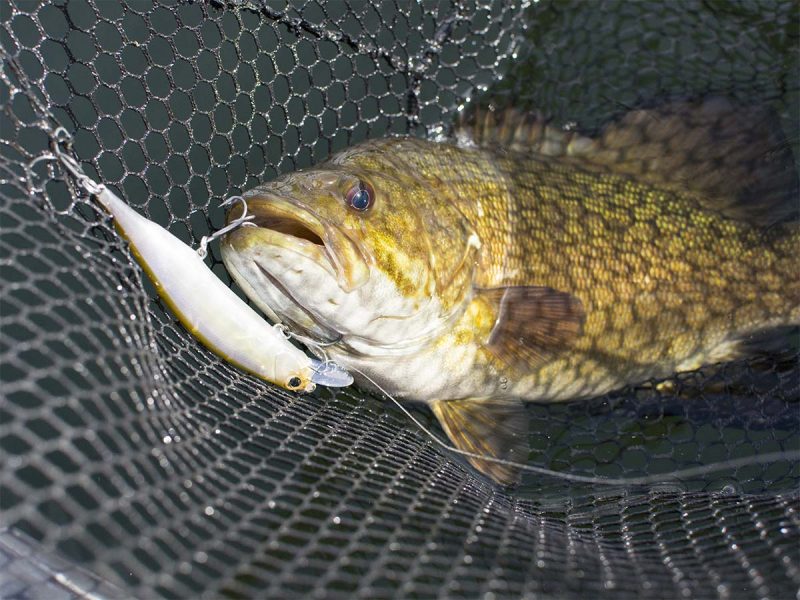Fishing a jerkbait can be an effective technique for catching various species of fish, especially bass. Here’s how you can fish a jerkbait:
1. Choose the right tackle: Select a medium to medium-heavy spinning or baitcasting rod and reel combo. Use a 6-10 lb monofilament or fluorocarbon line. The jerkbait itself should match the size of the baitfish in the water you’re fishing.
2. Determine the time and location: Jerkbaits work best during the spring and fall when fish are more active and searching for prey. Look for areas with shallow or medium-depth water near underwater structures like weed edges, drop-offs, submerged rocks, or sunken timber.
3. Retrieve technique: The key to fishing a jerkbait is mimicking injured or struggling baitfish. Start by casting the jerkbait towards your target area, allowing it to sink to the desired depth. Once it’s at the desired depth, hold your rod tip down and slightly to the side.
4. Jerk and pause: Use the rod tip to twitch the jerkbait, imparting a darting, erratic action. A typical technique is a sharp downward jerk followed by a slight pause, allowing the bait to suspend or slowly rise. Repeat this jerking and pausing action throughout the retrieve, varying the length and intensity of the jerks.
5. Pay attention to the feel: As you retrieve the jerkbait, you’ll be able to feel the action through the rod and line. Keep an eye out for any subtle strikes or line movement, as fish often hit jerkbaits during the pause between jerks.
6. Experiment with different depths and speeds: If you’re not getting any bites, try adjusting the depth at which you’re fishing the jerkbait. This can be done by adjusting your retrieval speed or using a jerkbait of a different weight or size. Change up your jerking and pausing cadence to see which one provokes the most bites.
Remember, practicing patience and experimenting with your technique is key when fishing with jerkbaits. It may take some time to hone in on the best approach for the specific fishing conditions, but once you find the right rhythm, you can hook into some exciting fish.
Know More About: how to fish a jerkbait
How to Fish a Jerkbait: Mastering the Art of Luring the Big Ones
Introduction:
When it comes to fishing, there are numerous techniques anglers rely upon to create the perfect environment for attracting the big ones. One such technique that has gained immense popularity among fishing enthusiasts is fishing with a jerkbait. A jerkbait is a versatile lure that imitates the action of a wounded fish, effectively enticing predator fish to strike. In this article, we will delve into the step-by-step process of effectively fishing with a jerkbait.
Choosing the Right Jerkbait:
To start off, it is crucial to select the right jerkbait for the specific fishing conditions. Consider the depth you want to fish in, as well as the type of fish you are targeting. Jerkbaits come in a variety of sizes, densities, and colors, so be sure to choose one that mimics the natural prey of your intended catch.
Rigging and Retrieving Techniques:
1. Rigging: Begin by attaching the jerkbait to your line using a reliable knot, such as the improved clinch knot. It is advisable to use a fluorocarbon line as it provides better control and improves sensitivity.
2. Casting: Cast your jerkbait towards areas where you suspect fish might be hiding, such as submerged structures, drop-offs, or rock formations. Accuracy is key, so take your time and aim for precise placements.
3. Retrieval: Once your jerkbait is in the water, use a combination of twitching and pausing to mimic the movements of an injured fish. Start by gently twitching your rod tip upwards, then pause for a few seconds. Repeat this action several times, keeping in mind that varying the length and speed of pauses can help in triggering more strikes.
Tips for an Effective Jerkbait Presentation:
1. Experiment with Depth: To ensure you are fishing at the right depth, consider adjusting the position of your rod tip. For shallow water, keep the rod tip low so that the jerkbait runs closer to the surface. In deeper water, raise the rod tip to allow the jerkbait to dive deeper.
2. Match the Hatch: Observe the natural baitfish in the area to determine the most appropriate color and pattern for your jerkbait. Matching the hatch will increase your chances of enticing fish to bite.
3. Vary Your Retrieval: Fish are not always predictable, so it is essential to keep experimenting with your retrieval technique. Adjust the speed, pause duration, and rod movement to find what works best on a given day.
4. Be Patient: Jerkbait fishing can require some patience, as it may take several casts before drawing the attention of fish. Stay persistent and focus on maintaining a steady retrieve with erratic pauses to attract predatory fish.
Conclusion:
Fishing with a jerkbait is an art that can yield rewarding results in terms of catching large, aggressive fish. Remember to choose the right jerkbait for the job, meticulously rig it, and employ the suitable retrieval techniques. By being attentive to the various factors that influence your success, such as depth, matching the hatch, and varying your presentation, you will significantly increase your chances of a successful fishing trip. So go out there, practice, and refine your jerkbait skills. Prepare to witness the excitement of fish striking your lure, resulting in unforgettable angling moments!
FAQs on how to fish a jerkbait
1. Q: What is a jerkbait for fishing?
A: A jerkbait is a fishing lure designed to mimic injured baitfish. It is typically made of hard plastic, with a realistic finish and a built-in weight system.
2. Q: What type of fish can I catch using a jerkbait?
A: Jerkbaits are effective for various species, including bass, trout, pike, walleye, and muskie. It is particularly popular among freshwater anglers.
3. Q: How do I choose the right jerkbait?
A: Consider the size, color, and diving depth of the jerkbait. Match the lure’s size to the size of the baitfish in the water, select colors that resemble local prey, and choose diving depths based on the target species’ feeding preferences.
4. Q: What is the best time to use a jerkbait?
A: Jerkbaits work well in colder water temperatures, typically during the fall, winter, and early spring months. They are also useful when fishing in shallow waters or around cover like rocks, docks, or submerged vegetation.
5. Q: How should I retrieve a jerkbait?
A: Jerkbaits require an erratic retrieve to mimic an injured baitfish. Use short, sharp twitches of your rod tip to make the lure dart and pause, imitating a struggling fish.
6. Q: What fishing gear should I use with a jerkbait?
A: A medium to medium-heavy spinning rod or baitcasting rod with a fast action is ideal for jerkbait fishing. Combining it with a high-quality reel and a low-stretch fishing line, such as fluorocarbon, enhances sensitivity for detecting strikes.
7. Q: Can I use a jerkbait in saltwater?
A: While jerkbaits are more commonly used in freshwater, they can also be effective for certain saltwater species such as stripers, snook, and redfish. However, make sure to select jerkbaits designed for saltwater fishing due to their increased durability.
8. Q: How should I work the jerkbait in different water depths?
A: In shallow water, use a more aggressive retrieve with shorter pauses. In deeper water, allow the jerkbait to sink to the desired depth, then use slower, longer twitches with slightly longer pauses.
9. Q: Can I modify a jerkbait to enhance its effectiveness?
A: Yes, you can experiment with different modifications like changing hooks to ones with a greater gap or replacing the split rings with heavier ones to enhance the lure’s action and hookup ratio.
10. Q: Are there any specific techniques for using a jerkbait in specific fishing conditions?
A: Yes, in colder water, a slower and more subtle retrieve is often effective. In warmer water, a more aggressive and erratic retrieve can trigger reaction strikes. Adapting your technique based on the conditions and fish behavior is crucial for success.

